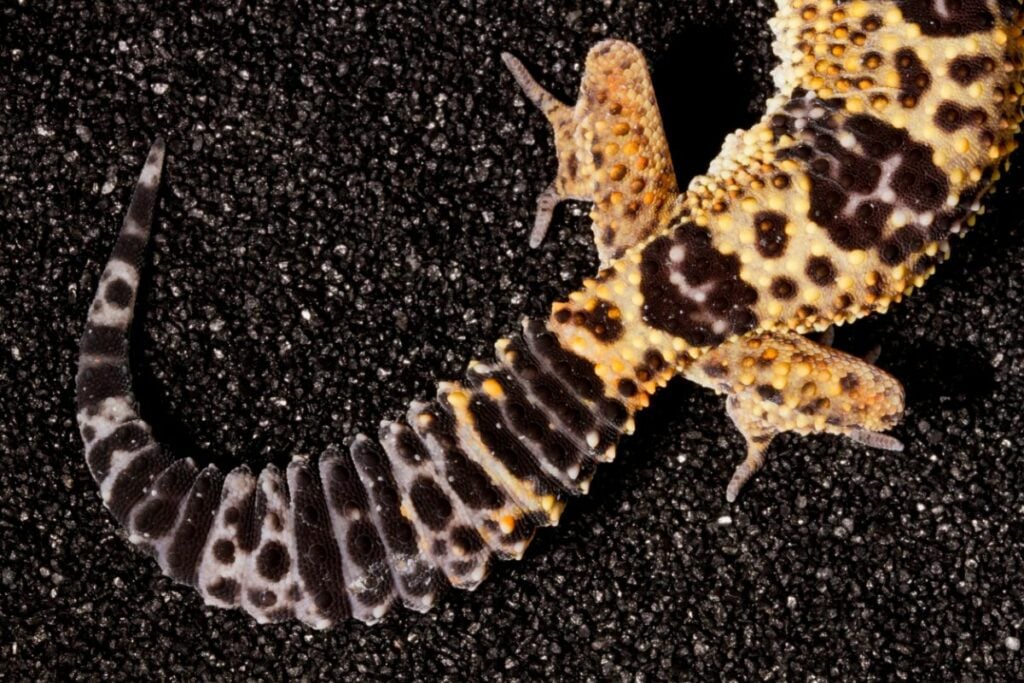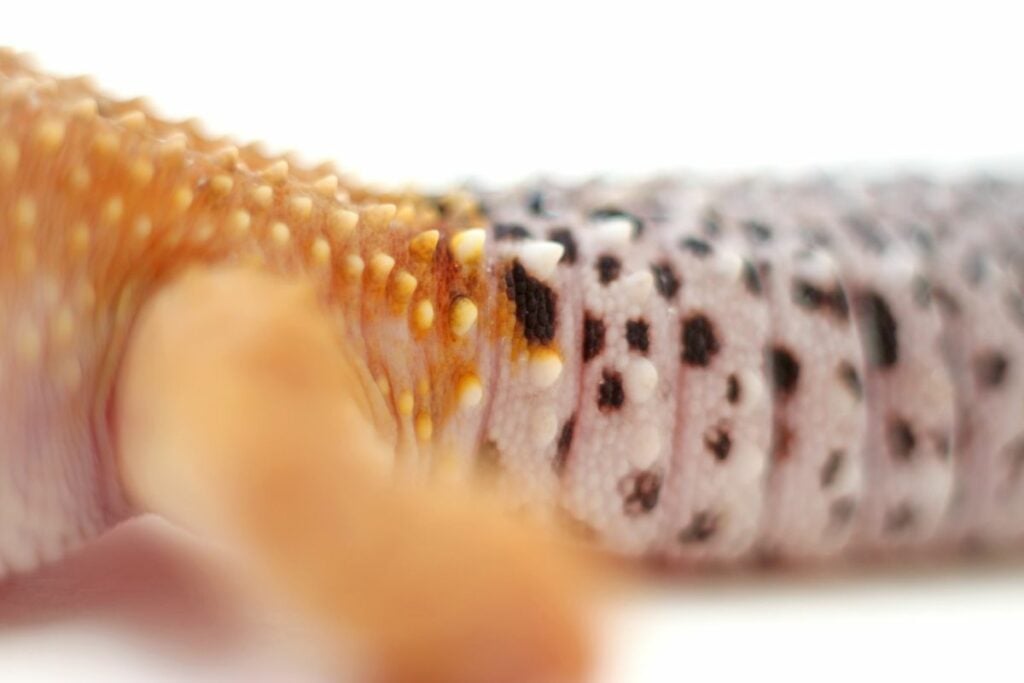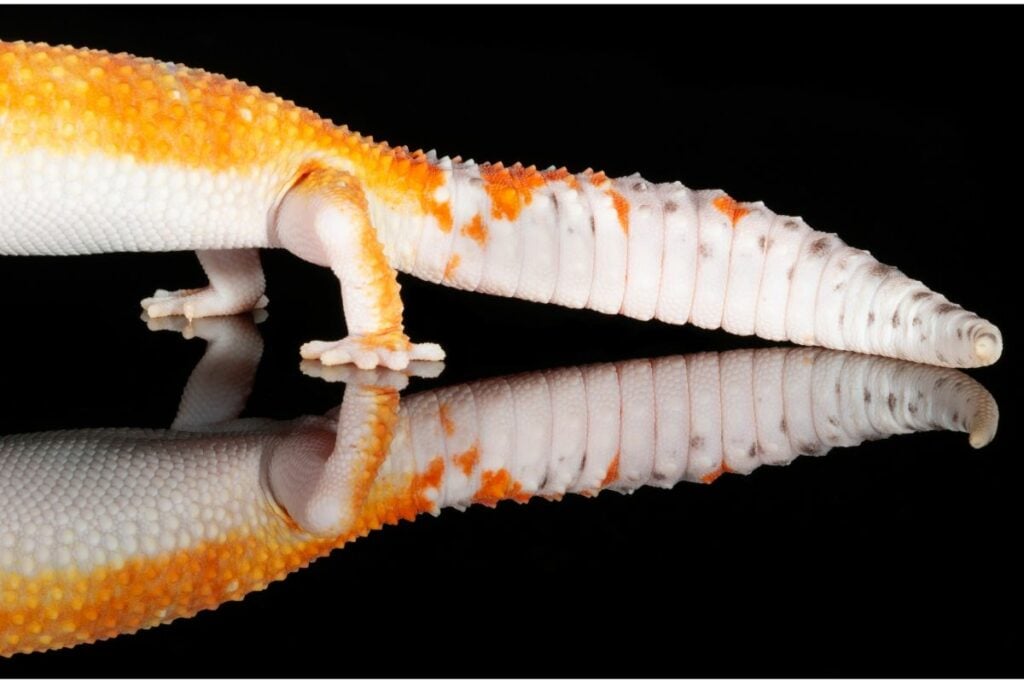The tails of a leopard gecko are one of its most interesting features. Generally, their tails should be fatter than their stomach, however, here, they are thinner.
Another interesting trait of leopard geckos is their ability to drop their tail. As such, you may wonder why they do this and how it works.

Well, typically, leopard geckos only drop their tails as a defense mechanism. Here, the dropped tail works as a distraction to their predators so they are able to run away.
Moreover, leopard geckos may also drop their tails when stuck, stressed, or, in some instances, sick. This is primarily due to fungal and bacterial infections that cause the tail to drop.
With this in mind, this guide will explore everything you need to know about leopard geckos and how easily they drop their tails (see also “Complete Leopard Gecko Poop Guide“).
Let’s get started.
What is Tail Dropping And Why Do Leopard Geckos Do It?
Tail dropping happens when geckos detach their tails from the base of their bodies. This usually takes place when a gecko is stressed, scared, sick, or facing a predator.
Likewise, it can also take place when you grab your gecko’s tails, shocking and startling the animal.
That said, leopard geckos can also drop their tails when stuck, too. For instance, if your gecko were to get its tail stuck in a door, it may choose to drop its tail to quickly escape.
Moreover, this act is completely voluntary, as opposed to tail loss. Once the tail is detached, it behaves the same way – bleeding and twitching. That said, the blood loss is minimal.
This is due to the fact that once your gecko drops its tail, the blood vessels inside will usually constrict.
In addition, there is a specific connective tissue located at the base of your leopard gecko’s tail which makes it easy for them to detach.
Although, you should keep in mind that once your gecko detaches its tail, the new one won’t look exactly the same. Typically, it is much shorter and blunter at the end. Plus, it may contain different colors, too.
Tail dropping shouldn’t be a common occurrence. In fact, it can provide unnecessary stress to your gecko and even impact its health.
Furthermore, what’s interesting is that geckos aren’t the only animals in the world to drop their tails either – other animals also drop their tails as a defense mechanism, too.
The name for this is autonomy.
Tall-Dropping Behavior In Young Geckos Compared To Adult Geckos

The younger the gecko, the easier it is for them to become stressed and spooked by the smallest issues, especially when living in the wild. When living in captivity, they will initially be scared for you, any fellow geckos, or anything else they perceive as a treat.
In response to this, they will sometimes lose their trail. That said, once you start familiarizing yourself with your gecko and socializing with others, they will become more at ease and less stressed.
Generally, adult geckos won’t lose their tails very often. If they know what to expect, they can accommodate their stress levels to this.
Although, this relaxed state is often only found in geckos bred in captivity, as opposed to ones found in the wild.
This is because, in captivity, they don’t have any natural predators, especially when they are living by themselves, they are in their own space, and are being socialized with humans.
However, if you were to keep numerous geckos in a small space, it may cause them to become stressed. Here, adult geckos may even bully younger ones.
For instance, a younger gecko might bite another gecko’s tail thinking it’s food or is attacking them – this could cause their tail to fall as a result.
This type of social interaction can cause stress to geckos, especially if they are young (see also “Types Of Geckos In Florida“).
In another instance, changes in the environment can also cause stress.
Tail-Dropping, Regeneration, And Pain
You may be wondering, does tail-dropping cause any pain to your gecko? How long does it take for their tails to regenerate again? Well, below, we will outline all of this in further detail.
Is Tail-Dropping Painful For Geckos
Geckos’ tails contain fracture points encircling their rapid vasoconstricting muscles. This means that once their tails drop, the muscles in the fracture points close in on themselves – preventing damage and blood loss.
Since the geckos aren’t rapidly losing blood, the pain they feel from their wounds is minimal. That said, it still remains to be a wound that needs to be treated.
Tail-Dropping
When leopard geckos are faced with an issue that feels like life and death, this provides a type of stress that causes their body to automatically prepare to shed their tails.
Regardless of whether they are faced with a predator or their tail has been caught between some rocks, their brain isn’t able to differentiate between the two.
How Many Times Can A Leopard Gecko Lose Its Tail?
Generally, geckos can only lose and regrow their tails twice in their lifetime. That said, others can do this much more frequently.
As such, there is no set limit when it comes to how many times your gecko can lose its tail. Although one thing is for sure – as your gecko gets older, they lose their ability to grow their tails.
Therefore, when an older gecko loses its tail, it is more likely to remain tailless as opposed to a younger gecko.
Likewise, another factor that impacts your gecko’s ability to regrow its tail is the circumstances in which it lost its tail.
While tails that have been intentionally dropped are easy to grow back, ones that have been cut off by a predator are much harder. If your gecko’s tail has been severely amputated by a predator, it can remain tailless for the rest of its life.
How Often Do Leopard Geckos Drop Their Tails?
Leopard geckos only drop their tails when they feel threatened, as such, this is not a common occurrence.
That said, if your gecko is shedding its tail regularly, then this is a sign that something in its environment is causing them stress.
This may mean separating them from their tankmates, avoiding handling them, or even resetting the tank.
How To Help Your Leopard Geckos Regrow Its Tail

When your leopard gecko drops its tail, it is essentially left with an open wound. Therefore, if your gecko loses its tail, you should follow the tips outlined below. These include:
- Allowing your gecko time to refamiliarize itself before removing it from its home and its housemates into a separate tank. Here, you’ll want to use paper towels or something similar as opposed to a loose substrate in their temporary home. This is because it has the potential of getting into your gecko’s wound site.
- Understand what caused your gecko to lose its tail to try and prevent this from happening in the future.
- Using a wet rag, clean your gecko’s wound – making sure to remove any remaining debris.
- Once done, apply some antiseptic to the site. This helps to prevent fungal and bacterial infections.
- Make sure the lighting, humidity levels, and temperature are all at an optimal setting.
- Ensure your gecko has plenty of water and lots of suitable feed such as mealworms and crickets to help your little guy regain their strength. Here, you can increase the number of insects you usually offer, however, remove any leftovers within 15 minutes to keep them from nibbling on their wounds.
- Make sure you limit handling frequency.
- Check for signs of infection. For instance, discharge, redness, and swelling. If you notice these, take your gecko to the vet immediately.
How To Prevent Your Gecko From Dropping Its Tail?
To make sure your gecko doesn’t lose its tail in a scuffle, you should follow the tips below. These include:
- Avoid holding your geckos too tightly, especially around the tail. For your gecko, this is a sign of danger, especially if you were to pinch it.
- Reduce the amount of time you’re handling your gecko – this prevents you from startling your pet into dropping its tail. Moreover, it helps you to avoid accidentally pulling off their tail, too.
- Ensure optimum lighting, temperatures, and humidity is all achieved. This ensures your gecko is stress-free.
- Make sure to house your gecko on its own. When housed with other animals, it can sometimes lead to aggression, even if they are all the same species. This may result in fights and potential tail losses.
Final Thoughts
Geckos are wonderful creatures with interesting trails. One of which includes the ability to drop their tails. This is usually performed as a defense mechanism against predators.
Regardless of whether your gecko is faced with a predator or simply spooked by a rock, these instances can cause them to drop their tail.
- Can Leopard Geckos Eat Silkworms? - March 11, 2024
- Do Leopard Geckos Climb? - March 4, 2024
- Do Leopard Geckos Bask? The Answer Will Surprise You - February 21, 2024
